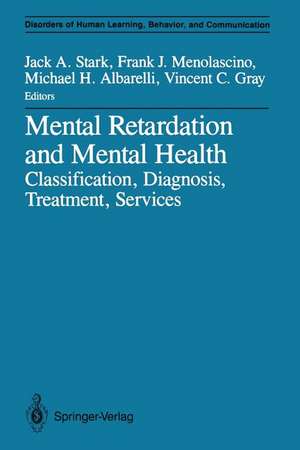Mental Retardation and Mental Health: Classification, Diagnosis, Treatment, Services: Disorders of Human Learning, Behavior, and Communication
Editat de Jack A. Stark, Frank J. Menolascino, Michael H. Albarelli, Vincent C. Grayen Limba Engleză Paperback – 21 sep 2011
Preț: 399.67 lei
Nou
Puncte Express: 600
Preț estimativ în valută:
76.48€ • 79.37$ • 63.93£
76.48€ • 79.37$ • 63.93£
Carte tipărită la comandă
Livrare economică 17-31 martie
Preluare comenzi: 021 569.72.76
Specificații
ISBN-13: 9781461283379
ISBN-10: 146128337X
Pagini: 496
Ilustrații: XXVIII, 464 p.
Dimensiuni: 155 x 235 x 26 mm
Greutate: 0.69 kg
Ediția:Softcover reprint of the original 1st ed. 1988
Editura: Springer
Colecția Springer
Seria Disorders of Human Learning, Behavior, and Communication
Locul publicării:New York, NY, United States
ISBN-10: 146128337X
Pagini: 496
Ilustrații: XXVIII, 464 p.
Dimensiuni: 155 x 235 x 26 mm
Greutate: 0.69 kg
Ediția:Softcover reprint of the original 1st ed. 1988
Editura: Springer
Colecția Springer
Seria Disorders of Human Learning, Behavior, and Communication
Locul publicării:New York, NY, United States
Public țintă
ResearchCuprins
Section I: Epidemiology.- 1 Prevalence and Implications of Maladaptive Behaviors and Dual Diagnosis in Residential and Other Service Programs.- 2 Maladaptive Behavior Among the Mentally Retarded: The Need for Reliable Data.- 3 The Association Between Mental Retardation and Psychiatric Disorder: Epidemiological Issues.- 4 The Need for a National Epidemiological Study.- 5 Data Collection at the National Institute of Mental Health.- Conclusion.- Section II: Developmental Aspects of Prevention.- 6 The New Morbidity: Implications for Prevention.- 7 Psychiatry, Neuroscience, and the Double Disabilities.- 8 Attentional and Neurochemical Components of Mental Retardation: New Methods for an Old Problem.- 9 Prevention and Early Treatment of Behavior Disorders of Children and Youth with Retardation and Autism.- Conclusion.- Section III: Clinical Research and Training.- 10 Mental Illness in the Mentally Retarded: Diagnostic and Treatment Issues.- 11 Integrative Approach to Diagnosis of Mental Disorders in Retarded Persons.- 12 Comprehensive Management of the Mentally Retarded/Mentally Ill Individual.- 13 Psychiatric Examination of Mentally Retarded Persons: General Problems and Challenges.- Conclusion.- Section IV: Clinical Treatment Issues.- 14 Behavior Therapies: Past, Present, and Future.- 15 Mental Health of Persons with Mental Retardation: A Solution, Obstacles to the Solution, and a Resolution for the Problem.- 16 Orthomolecular Principles in Treatment of Persons with Mental Retardation and Mental Illness.- 17 Balanced Treatment and Assessment Approaches.- 18 Issues Related to Applied Behavioral Analysis.- 19 Ethical Issues in Interventions for Persons with Retardation, Autism, and Related Developmental Disorders.- 20 Ethical Issues of Aversive Techniques: A Response to Thompson, Gardner, and Baumeister.- 21 Behavioral Psychopharmacology: A New Psychiatric Subspecialty.- Conclusion.- Section V: Program Models.- 22 A University-Based Demonstration Program on Outpatient Mental Health Services for Mentally Retarded People.- 23 A County Systems Model: Comprehensive Services for the Dually Diagnosed.- 24 Intensive Home-Based Treatment Interventions with Mentally Retarded/Emotionally Disturbed Individuals and Their Families.- 25 RIP: A Parent-Implemented Treatment Model for Families with Behaviorally Disordered and/or Developmentally Delayed Young Children.- 26 The Education and Treatment of Behavior-Disordered Mentally Retarded Children.- 27 Transitional Services in the Habilitation of Mentally Retarded Individuals with Mental Health Needs.- Conclusion.- Section VI: Legal Issues.- 28 The Role of Legislation.- 29 Residential Placement of “Dual Diagnosis” Clients: Emerging Legal Issues.- 30 Clients in Limbo: Asserting the Rights of Persons with Dual Disabilities.- 31 The Dually Diagnosed Client in the Criminal Justice System.- 32 Future Litigation Strategies.- 33 Fifteen Questions: Ethical Inquiries in Mental Retardation.- Conclusion.- Section VII: Service Systems.- 34 Service Delivery Trends: A State-Federal Policy Perspective.- 35 Systems Issues in Meeting the Mental Health Needs of Persons with Mental Retardation.- 36 Abandoning Facility-Based Programs: Evolving Toward a “Service-Based” Model (The Rock Creek Foundation).- 37 The Lancaster County Mentally Retarded Offenders Program.- 38 Past, Present, and Future Roles for Institutional Settings in the Care of Mentally Retarded/Mentally Ill Persons.- 39 The North Carolina Willie M. Program: One Model for Services to Multiply Handicapped Children.- 40 Developing a System of Services forthe Dually Diagnosed Adult Population in North Carolina: After Willie M..- 41 Families and the Developmental Needs of Dually Diagnosed Children.- Conclusion.- Author Index.



























